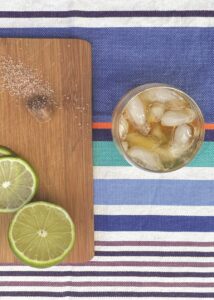One of the pleasures of my semi-annual trek to Cape Cod is catching up with friends who convene here every year. Some, like me, come from New Orleans; others I’ve met here over the years. These visits usually lead to sampling a new restaurant or catching a new show. Sometimes, they’ve introduced me to a beloved part of Provincetown social life.
A few years ago, I made plans to spend the day with a friend, a former New Orleanian now living in New York. I arrived at his Provincetown rental and met the posse of guys he was sharing the house with. He offered me vodka, vodka, or vodka, then told me to get ready to go out. “Where to?” I asked.
“Tea dance at the Boatslip.”
On arriving, I took in the scene: scantily clad partygoers, thumping music, a gorgeous view over the water. I was confused. You see, I was expecting tea.

I still assert this was not an unreasonable expectation. As a Southern girl, I heard “tea,” so tea there must be, probably iced. Though, to be fair, there was undoubtedly at least one tea on offer — of the Long Island variety.
No tea? Oh well. I ordered not-vodka and started dancing.
After a few rounds on the dance floor, I asked my friend why it was called a tea dance. He surmised it was probably because it happened around teatime. I remembered that my junior-high dance dress code called for a “tea-length dress,” though I had never since pondered that nomenclature. It turns out my junior-high soiree and the Boatslip’s daily dance party share a theme.
The tea dress emerged in the late 19th century. Unlike the restrictive, heavy brocaded dresses of the Victorian era, a tea dress was loose fitting, made for lounging in one’s home while hosting intimate tea parties.
Over time, the party moved out of the house and the hemline moved up a bit, permitting dancing. By the 1920s, the tea dress was worn to a tea dance, so named because it was held at teatime, and the hostess served cake and tea.
Fast forward to the 1960s when Michael Fesco, owner of the Ice Palace, a bar on Fire Island, was looking for ways to drum up business on slow Sunday afternoons. He threw a mid-afternoon dance party where, according to Vice magazine, “Local drag queens served tea from a big silver pot and trays with delicate cups and saucers.” Soon Sunday tea dances were popping up at gay bars across the country.
The tea dances of yore evoke a wholesome scene: tables laden with cake and tea with nary a vodka-soda in sight. There is one old-fashioned tea drink, however, that might suit revelers heading to a tea dance’s more modern incarnation: an 18th-century punch made with tea.
Prior to the 19th-century rise of the cocktail, imbibers quenched their thirst around the punch bowl. This communal tipple had a basic recipe that can easily be remembered, no matter how many glasses you have already quaffed: One of Sour, Two of Sweet, Three of Strong. Four of Weak.
The sour was citrus, usually lemon or lime; the sweet was sugar; the strong was booze; and the weak was water. Often the water was replaced with a wildly popular new beverage: tea. In his book Punch: The Delights (and Dangers) of the Flowing Bowl, David Wondrich chronicles the story of punch and includes recipes from across the centuries and around the world.
The recipe below is inspired by Wondrich’s history. Be forewarned: this complex and eminently satisfying beverage in no way resembles the Hawaiian Punch of your childhood or the Jungle Juice of your college years, although like the latter, it can be made ahead and serves a crowd.
(On the subject of making things ahead, if you don’t travel with simple syrup, make it by combining one cup water and one cup turbinado sugar in a small saucepan; heat, stirring, until sugar is dissolved; cool and refrigerate. Freeze a big bowl of water overnight to make an ice block.)
Mix it in a fancy cut-glass bowl dressed up with an ice ring, or just serve it in whatever mixing bowl your rental came with. Regardless, it seems a fitting pregame beverage before heading to the Boatslip.
Or perhaps the folks there might serve it as part of a throwback 1960s-themed day — a nod to that original tea dance party featuring Mary Quant-togged drag queens sashaying through the crowd bearing teapots, cups, and cheer.
Heading to Tea Dance Punch
Serves 15
1½ cups simple syrup (ideally made with turbinado sugar)
1 cup fresh-squeezed lime juice (from about 8 limes)
2 (750 ml) bottles light rum (or 1 bottle rum and 1 bottle cognac)
2 quarts cold black tea
Ice block
Nutmeg for grating (use whole, not pre-grated)
- Mix the simple syrup, lime juice, spirits, and tea in a large bowl and refrigerate for several hours.
- If using an ice block, add it to the bowl 30 minutes before serving. Otherwise serve punch over ice. Taste and adjust the balance of sweetness and acidity if needed. Grate nutmeg on top of bowl or leave near the bowl and allow guests to grate their own.



